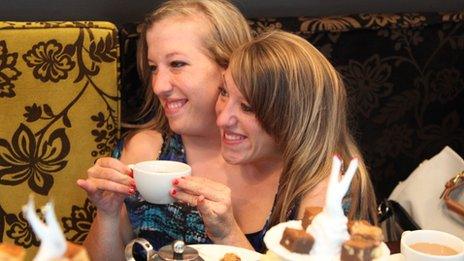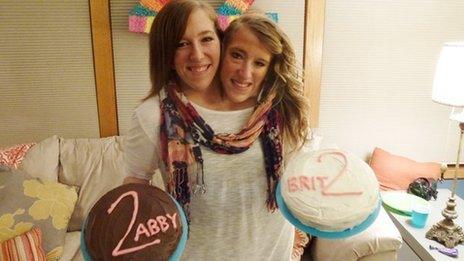Living a conjoined life

Abby and Brittany Hensel, the inseparable twins determined to lead the typical, active lives of typical 20-somethings, are a remarkable testament to human resilience. They’ve pursued higher education, embarked on journeys, and secured employment. However, the question remains: how feasible is it for two individuals to coexist within a single body?
Much like any other 23-year-olds, Abby and Brittany Hensel relish spending quality time with friends, going on vacations, driving, engaging in sports like volleyball, and fully embracing life’s experiences.
These identical, conjoined twins hailing from Minnesota, USA, have successfully graduated from Bethel University and are embarking on their careers as elementary school teachers, with a special focus on mathematics. While they possess two teaching licenses, a practical financial aspect sets them apart.
“Clearly, we understand right away that we’ll be receiving one salary since we’re performing the duties of one person,” Abby notes. “As we gain more experience, we’d like to explore some negotiation, considering we hold two degrees and can offer two distinct teaching perspectives.”
Brittany adds, “One of us can take on the role of teaching while the other monitors and addresses questions. In this manner, we can accomplish more than a single person.”
Their friend, Cari Jo Hohncke, has always been inspired by the sisters’ collaborative spirit.
“They are two distinct individuals, yet they seamlessly collaborate to carry out everyday functions that I often take for granted,” remarks Hohncke.
The twins know each other so well that they often say the same things or finish each other’s sentences, and are supportive and understanding of the other in all aspects of life.
With two sets of lungs, two hearts, two stomachs, one liver, one large intestine and one reproductive system, they have learned from a young age to co-ordinate their body, with Abby controlling the right hand side and Brittany the left.
There is a difference in height and at 5ft 2in (1.57m) Abby is taller than her sister Brittany who is 4ft 10in (1.47m). As their two legs are different lengths, Brittany has to stand on tip toe, on her leg, to ensure they maintain their balance.
They have had to learn to reach compromises on everything from what food they eat to their social life and even the clothes they wear.
“We definitely have different styles,” says Abby. “Brittany’s a lot more like neutrals and pearls and stuff like that and I would rather have it be more fun and bright and colourful.”
While Abby is seen as the “outspoken” sister and will always win the argument about what they are going to wear, Brittany says her twin is also much more of a “homebody,” whereas she prefers going out.
There are other differences too. Brittany is scared of heights, whereas Abby is not. Abby is interested in maths and science, while Brittany prefers the arts.
They also respond differently to coffee. After a few cups Brittany’s heart rate increases, but Abby is not affected.

And they have different body temperatures.
“I can be a totally different temperature than Brittany would be,” says Abby, “and a lot of times our hands are different temperatures, so I get super-hot way faster.”
Despite having a normal family and social life, studying and working like any other young women, they do face some additional problems.
For example, they have to put up with speculation about their private life – something they prefer not to discuss. The twins deny a rumour that Brittany has become engaged, describing it as a “dumb joke”.
Travelling to a new country with friends on holiday is also not as straightforward for conjoined twins. They have two passports, but one ticket as they only take up one seat on the aeroplane. However they also have to be on their guard and more aware of entering crowded or confined spaces because members of the public will often try to take unwelcomed photographs.
As a close friend of the twins Erin Junkans says you always need to be alert because you never quite know how people are going to react or what they are going to say.
“I want to make sure that they’re safe and that they’re not completely exposed, definitely just standing in the way of pictures, just always keeping an eye on what’s going on and just how the girls are reacting to the crowds,” says Junkans.
“Sometimes if they get more overwhelmed then… we just need to get away from [the] area for a little bit, but they amaze me at their ability to just shake it off and keep seeing what we are there to see.”
Conjoined twins are very rare – it is thought one in every 200,000 births – and around 40-60% of these births are delivered stillborn. Female siblings tend to have a better survival rate than male siblings.
Any operation to separate conjoined twins is a highly complex and dangerous process. It was a risk that Abby and Brittany’s parents did not want to take for fear that one of the twins might not have survived the surgery or have the same quality of life they do now.

With possibly fewer than 12 adult pairs of conjoined twins across the world today, Abby and Brittany Hensel are defying the odds. Their mother, Patty Hensel, says her hopes and aspirations for her daughters’ future are just the same as anyone else’s.
“Like every mum would hope for, you want them to be successful and to be happy and healthy as they’re being successful and that’s what I want,” says Patty Hensel.
As they embark on their working life together, the twins aim to take things day by day and do not tend to look forward to where they will be or what they will be doing in 10 years’ time.
With their position as teachers they have become role models for children academically, but also in their attitude to life, overcoming any challenges.
“I don’t think there’s anything that they won’t try or something that they couldn’t be able to do if they really wanted to,” says Paul Good, principal of the school where Abby and Brittany work.
“To bring that to children, especially kids who might be struggling, that’s very special, that’s learnt through lived example.”



